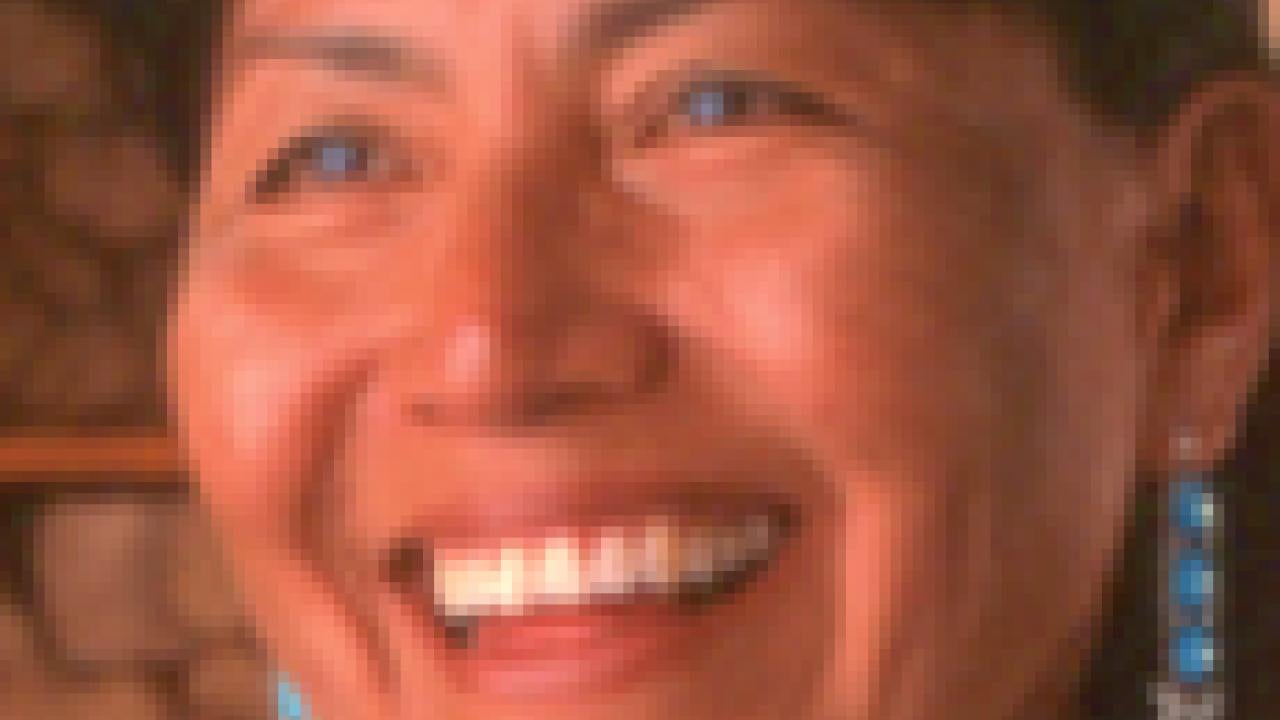On the Navajo Nation in Arizona, looking in any direction from her ancestral home, D.Y. Begay sees cliff formations “outlined in stepped patterns painted in bundles of red streaks, subtle shades of pinks, clusters of dusty-ochre, and flickering sand-tone colors.”
“At dawn, shoots of pale baby blue awaken the sky, and I sometimes see deep dark indigo, pinks and shades of soft yellows.”
It is images like these that the fourth-generation weaver turns into lasting treasures of natural beauty — she calls them tapestries, created in a blend of traditional weaving techniques and contemporary design. Eighteen of them comprise the C.N. Gorman Museum’s winter exhibition, The Weavings of D.Y. Begay, opening Tuesday (Jan. 8).
This is the first show of the museum’s 40th anniversary year, a celebration that focuses on Navajo art — honoring the Navajo artist for whom the museum is named, Carl Nelson Gorman, a founding member of the Native American studies faculty.
Veronica Passalacqua, curator, gathered the Begay works from the weaver herself and from other collections, and prepared a 32-page catalog showing everything in the exhibition (the catalog is priced at $14.95).
The exhibition is scheduled to run through March 15. A reception and lecture by the artist are set for the afternoon of Tuesday, Feb. 12: reception at 4, lecture at 4:30.
Writing for the catalog, the award-winning weaver says her inspiration comes primarily from her home environment on the Navajo reservation. “I grew up on the vast open land of the ‘middle road’ homestead in Tselani, Ariz. In my language, Tselani translates as ‘many rocks.’
“It is a remote community tucked away among white cliffs, and with walls sculpted by wind and erosion. The conical shaped cliffs are majestically molded into elongated, searing, vertical formations, and the tops are capped with mushroom-shaped structures.
Light, color and memories
“The sunrise is often my canvas — it seduces my imagination with colors, curiosity and beauty. These images are replaced at the end of the day by flaming oranges as the sun sets for the evening and night takes on dark, forbidding colors.
“These daily encounters with light, color, remarkable land formations and a lifetime of memories are the textures I reflect on, interpret and explore in my tapestries.”
She learned to weave at an early age, and was involved in the yarn-making process from raising sheep to shearing them for their wool, to cleaning and carding it, and spinning it.
“Some of my early weavings conformed to the various Navajo regional or ‘traditional’ patterns,” she wrote. “However, I was not totally enamored with this inflexible style and its repetitive motifs. I wanted to invent and explore my own ideas.”
In fiber arts courses at Arizona State University, she received an introduction to many styles of weaving from around the world. “I became engrossed in researching different weaving techniques and materials,” she wrote. “I began a new phase of experimentation with my own weaving.”
In the 1990s, while raising her son and spending more time at home, “I felt compelled to explore my own style and follow my aspirations for designing and dyeing.”
She recalled her “days spent roaming the desert and eroded washes that were deep and endless, with vibrant colored soil and vegetation that cradled colors for dyes.”
“My resources for color are lodged in dried, weathered locations, forbidding holes, crevices in canyon walls and tree trunks.”
But, while she has drifted away from traditional Navajo style, “I adhere to the same weaving techniques that have been passed down for generations.”
Art that lives, evolves
In an essay for the exhibition’s catalog, Northern Arizona University’s Jennifer McLerran, a specialist in Navajo weaving, says of Begay’s work: “Both informed by and reflective of traditional environmental knowledge, her work and practice are — like the indigenous culture from which they have arisen — living and evolving, adapting to change yet retaining their significance as expressions of a core set of values and beliefs.
McLerran, an assistant professor of Native American art history and museum studies, continued: “Navajo weaving persists as an important contemporary practice that stems from and reinforces knowledge and stewardship of the natural and cultural environment and demonstrates the interdependence of the two.”
In her artist statement, Begay says the yarns and dyes that she uses “are intimately related to our sheep and our land. I feel a great connection to the plants that I now gather to produce colors that so appealed to me as a young girl.”
“I love exploring ways to express my own style and personal interpretations to capture the soul of Mother Earth.”
Hulleah J. Tsinhnahjinnie, associate professor of Native American studies and director of the C.N. Gorman Museum, says in the catalog: “We are honored” to present the Begay exhibition to launch the museum’s 40th anniversary year.
“The memories of the founders of the Native American Studies Department, Jack Forbes, Sarah Hutchison, Dave Risling and Carl Nelson Gorman, are also honored with the presence of such a master artist.
“Ahéhee´ (thank you), D.Y., for blessing our modest museum with your treasures.”
The C.N. Gorman Museum is in 1316 Hart Hall. Regular hours: noon-5 p.m. Monday-Friday and 2-5 p.m. Sunday. Free admission,
Follow Dateline UC Davis on Twitter.
Media Resources
Dave Jones, Dateline, 530-752-6556, dljones@ucdavis.edu
